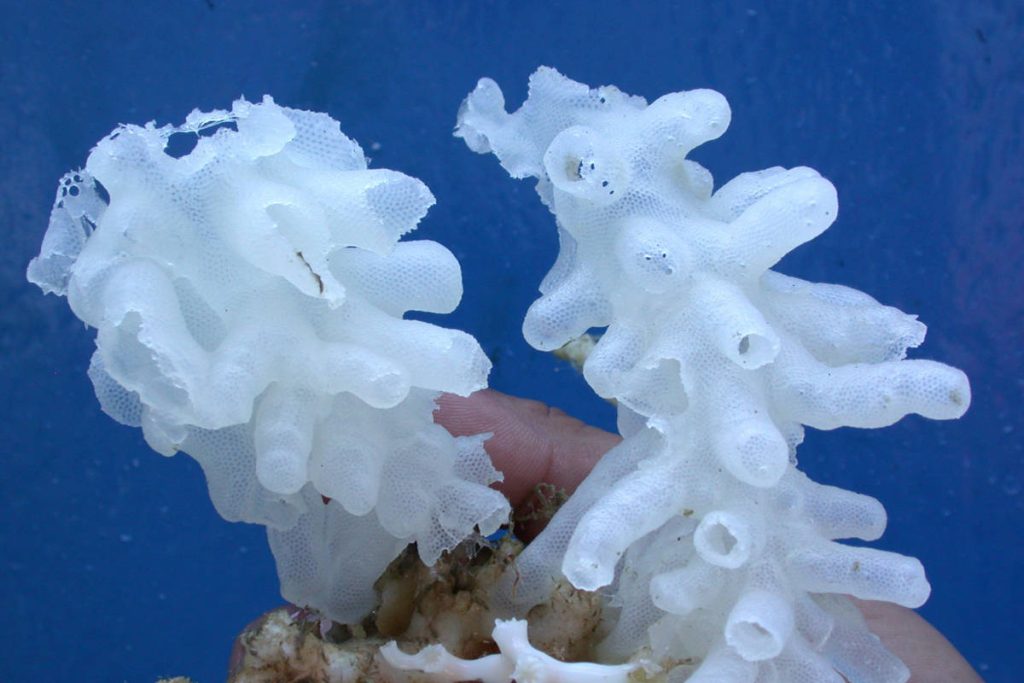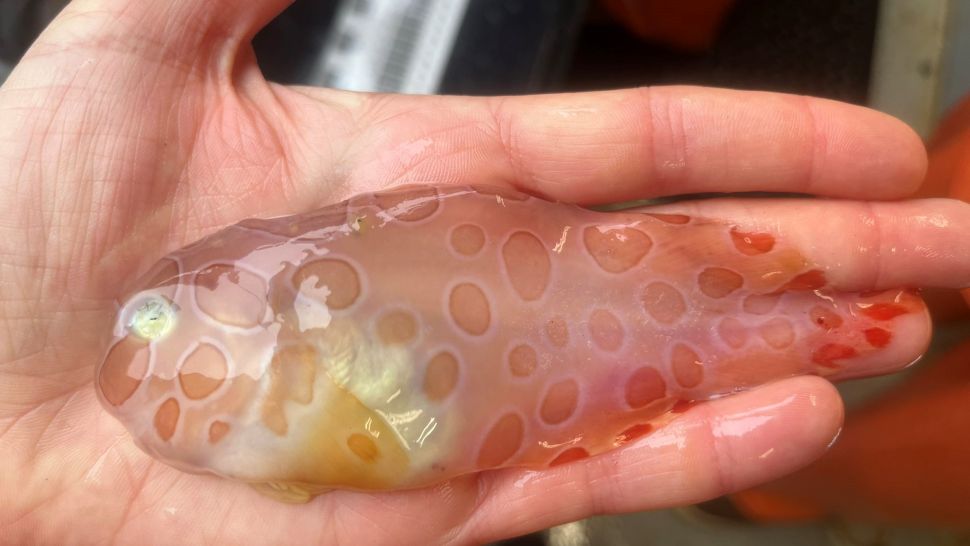Ironically, scientists were exploring a section of the Pacific Ocean known as the Clarion-Clipperton Zone (CCZ) because it is believed to be rich in precious mineral depots. The Clarin-Cliperton Zone is a mineral-rich area of the ocean floor that measures approximately 2.3 million square miles in an area between Hawaii and Mexico. Fortunately, in the process of estimating the risk of extinction of the species of sea creatures, scientists discovered some 5,578 new species living on the seabed. It is estimated that 88% to 92% of the new species have never been seen before.
Of the many new species discovered perhaps one of the most unusual has been nicknamed the “gummy squirrel”.
The most common types of creatures found in the CCZ are arthropods, worms, echinoderms (spiny invertebrates like sea urchins) and sponges. It is interesting to note the sponges range from looking like familiar bath sponges to some that like vases. One of the researchers, Muriel Rabone was particularly impressed with the “glass sponge” She told Tree Hugger.com: “They have little spines and under the microscope, they look like tiny chandeliers or little sculptures.”

The study has as its goals the following statement, “There is a growing interest in the exploitation of deep-sea mineral deposits, particularly on the abyssal seafloor of the central Pacific Clarion-Clipperton Zone (CCZ), which is rich in polymetallic nodules. To effectively manage potential exploitation activities, a thorough understanding of the biodiversity, community structure, species ranges, connectivity, and ecosystem functions across a range of scales is needed. The benthic megafauna plays an important role in the functioning of deep-sea ecosystems and represents an important component of biodiversity. While megafaunal surveys using video and still images have provided insight into CCZ biodiversity, the collection of faunal samples is needed to confirm species identifications to accurately estimate species richness and species ranges, but faunal collections are very rarely carried out. Using a remotely operated vehicle, 55 specimens of benthic megafauna were collected from seamounts and abyssal plains in three Areas of Particular Environmental Interest (APEI 1, APEI 4, and APEI 7) at 3100–5100 m depth in the western CCZ. Using both morphological and molecular evidence, 48 different morphotypes belonging to five phyla were found, only nine referable to known species, and 39 species potentially new to science. This work highlights the need for detailed taxonomic studies incorporating genetic data, not only within the CCZ, but in other bathyal, abyssal, and hadal regions, as representative genetic reference libraries that could facilitate the generation of species inventories.”

The results of this study state that, “A total of 55 specimens were collected in the western CCZ (Table 1). Based on molecular data these represent 48 species of invertebrate megafauna (43 singletons, four doubletons, and a single species with four representatives) belonging to ten classes in five phyla. However, for three of the doubletons, each specimen was collected in a different APEI, but all were consistently found in the same geoform (i.e., abyssal plain, seamount, or seamount slope). Most of the taxa were collected on the abyssal seafloor (36 specimens from 33 species) > 4800 m deep, followed by seamounts (17 specimens from 13 species) between 3095–3562 m deep and only two specimens from two species collected on a seamount slope at 4125 m deep. Out of the 48 taxa, only nine were assigned to previously described species, all from adjacent regions such as the Kuril-Kamchatka, Mariana, and Izu-Bonin Trenches, the South China Sea, and other areas of the Northwest and Southwest Pacific.”
Dr. Adrian Glover is a deep-sea biologist at the Natural History Museum in London. He is also the senior author of the study and has taken part in several of the UK’s Smartex expeditions. He described his work as an “incredible privilege.” Dr. Glover describes the seabed as an amazing place. Were, despite the extreme cold and dark. Life thrives. He points to the lack of food in the zone, but life has a way of persisting in the deep, dark, cold deep sea. He said, “It’s a mystery.” To observe this life biologists used remote-controlled vehicles back and forth across the seabed some three and a half miles below the surface.
The plans now are for mining to begin. Seventeen deep-sea mining contracts in the area have been granted. Countries including the UK, US and China want to locate and mine minerals including cobalt, manganese, and nickel which it is anticipated will be in high demand by alternative energy companies. Their work will be closely monitored to minimize the impact on the deep-sea creatures
It should be noted that some scientists like Sir David Attenborough see a very real danger and are calling for a moratorium on deep-sea mining. The Guardian Newspaper wrote, “Sir David Attenborough has urged governments to ban deep sea mining, following a study warning of “potentially disastrous” risks to the ocean’s life-support systems if it goes ahead.
The study, by Fauna and Flora International (FFI), warns that proposed plans to mine the seabed could cause significant loss of biodiversity, disruption of the ocean’s “biological pump”, and the loss of microbes important for storing carbon. The process, requiring machines operating thousands of meters under the sea, could also create plumes of sediment that smother areas far from the mining sites and kill wildlife.
Dozens of exploratory licenses, two of which are sponsored by the UK, have already been granted for huge tracts of the sea bed, ahead of a race to mine commercially for ores and minerals such as copper, used in mobile phones and batteries. But the rules to govern the responsible exploitation of this global resource are not finalized – they are expected to be completed at a meeting in July at the UN International Seabed Authority.
Attenborough, the vice president of FFI, said deep-sea mining could create a ‘devastating series of impacts’ threatening processes critical to the health and function of the oceans and called on governments to be guided by scientists.
‘Fauna & Flora International is calling on global governments to put in place a moratorium on all deep-sea mining – a call I wholeheartedly support,’ Attenborough said.
In a foreword to the report, Attenborough said it was ‘beyond reason” for countries to consider the destruction of deep-sea places before they understood them or the role they play in the health of the planet.
Attenborough said: “The rush to mine this pristine and unexplored environment risks creating terrible impacts that cannot be reversed. We need to be guided by science when faced with decisions of such great environmental consequence.’
FFI warned that human activity was already putting a huge strain on the oceans, which have absorbed a third of our carbon emissions and 93% of the extra heat trapped by the rising concentration of greenhouse gases.”
Obviously, mining the seabed is a threat to sea creatures. How much remains to be seen. Meantime marine biologists are enjoying what is one of the great discoveries of new species in centuries.
